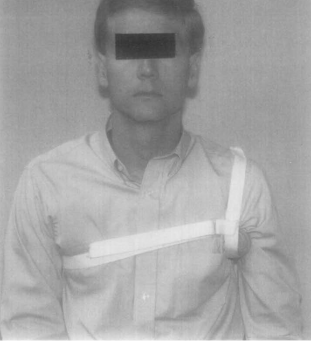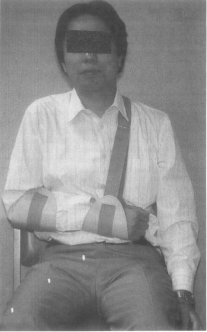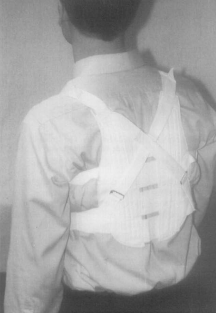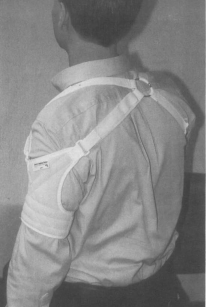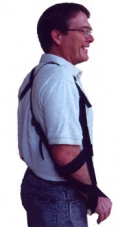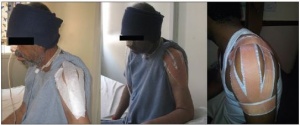Hemiplegic Shoulder Subluxation: Difference between revisions
mNo edit summary |
mNo edit summary |
||
| Line 21: | Line 21: | ||
* Tapping:A study conducted by Chatterjee et al found California Tri-pull Taping method to reduces pain, improves active shoulder flexion, and improves distal UE functional ability. This appears to be a promising early adjunctive treatment for clients who have suffered a stroke and demonstrate pain in a subluxed shoulder. This taping method allows the patients to participate in all active UE exercises as well as all ADL's. However, there was no follow-up to determine if the effects demonstrated were maintained.<ref>Subhasish Chatterjee, Kate A Hayner, Narkeesh Arumugam, Manu Goyal, Divya Midha, Ashima Arora, Sorabh Sharma, Senthil P Kumar. The California Tri-pull Taping Method in the Treatment of Shoulder Subluxation After Stroke: A Randomized Clinical Trial.N Am J Med Sci. 2016 Apr;8(4):175-82. doi: 10.4103/1947-2714.179933 </ref> | * Tapping:A study conducted by Chatterjee et al found California Tri-pull Taping method to reduces pain, improves active shoulder flexion, and improves distal UE functional ability. This appears to be a promising early adjunctive treatment for clients who have suffered a stroke and demonstrate pain in a subluxed shoulder. This taping method allows the patients to participate in all active UE exercises as well as all ADL's. However, there was no follow-up to determine if the effects demonstrated were maintained.<ref>Subhasish Chatterjee, Kate A Hayner, Narkeesh Arumugam, Manu Goyal, Divya Midha, Ashima Arora, Sorabh Sharma, Senthil P Kumar. The California Tri-pull Taping Method in the Treatment of Shoulder Subluxation After Stroke: A Randomized Clinical Trial.N Am J Med Sci. 2016 Apr;8(4):175-82. doi: 10.4103/1947-2714.179933 </ref> | ||
[[File:Tapping.jpg|center|thumb|300x300px|<ref>Subhasish Chatterjee, Kate A Hayner,1 Narkeesh Arumugam,2 Manu Goyal, Divya Midha, Ashima Arora, Sorabh Sharma, and Senthil P Kumar. The California Tri-pull Taping Method in the Treatment of Shoulder Subluxation After Stroke: A Randomized Clinical Trial. N Am J Med Sci. 2016 Apr;8(4):175-82. doi: 10.4103/1947-2714.179933</ref>]] | [[File:Tapping.jpg|center|thumb|300x300px|<ref>Subhasish Chatterjee, Kate A Hayner,1 Narkeesh Arumugam,2 Manu Goyal, Divya Midha, Ashima Arora, Sorabh Sharma, and Senthil P Kumar. The California Tri-pull Taping Method in the Treatment of Shoulder Subluxation After Stroke: A Randomized Clinical Trial. N Am J Med Sci. 2016 Apr;8(4):175-82. doi: 10.4103/1947-2714.179933</ref>]] | ||
{{#ev:youtube|ivgBxzFwbUE}} | |||
Revision as of 00:07, 8 May 2018
Original Editor - Fasuba Ayobami
Top Contributors - Vaibhav Panchal, Manisha Shrestha, Fasuba Ayobami, Yesmine Gouddi, Kim Jackson, Lucinda hampton, Mohamed Abdelraof Mohamed, Candace Goh, Shreya Pavaskar, Dinu Dixon, Naomi O'Reilly, Mariam Hashem, Amanda Ager, Lauren Lopez and Robin Tacchetti
Introduction[edit | edit source]
Shoulder subluxation is one of the major complications experienced among stroke survivors. It was observed that approximately 84% of stroke survivors will have Shoulder subluxation and related shoulder pain.[1] Shoulder subluxation may occur early on in the hemiplegic arm due to flaccid supporting shoulder musculature and can be exacerbated by external forces.[2] However, Patients with shoulder subluxation may not have Hemiplegic Shoulder Pain while patients with Hemiplegic Shoulder Pain may not have shoulder subluxation.[3] On this page, emphasis is centred on Physical therapy management. Kindly refer to Shoulder Subluxation for more details
Physical Therapay Management[edit | edit source]
Acute Management[edit | edit source]
- Education: Caregivers/Health Professionals/Relatives need to be informed on the importance of proper handling of the arm. Stroke patients who have their arm unsupported and/or handled inappropriately by caregivers (pulling on the arm) are at a higher risk for traction nueropathy and injury. Hence, it is essential that caregivers of stroke survivors are adequately trained in handling the hemiplegic arm especially when shoulder subluxation is present.[1][4][5]
- Positioning: Lap trays, Pillows and foam support help to keep the arm and shoulder supported in the correct position. Good positioning will help reduce strain on your ligaments and prevent frozen shoulder from occurring.[1][4][6]
- Orthotic devices: The use of shoulder supports is common early after stroke to decrease glenohumeral subluxation and support the shoulder joint. Examples of shoulder supports are the Henderson shoulder ring, Bobath roll, Harris hemi-sling, Rolyan humeral cuff sling, Cavalier shoulder support, arm trough or lapboard and shoulder strapping.[1] A study conducted by Nadler et al found reducing vertical subluxation with a shoulder orthoses may reduce hemiplegic shoulder pain. Orthosis with proximal and distal attachments are more effective.[7] In addition, care must be take in its usage to avoid contractures.
- Tapping:A study conducted by Chatterjee et al found California Tri-pull Taping method to reduces pain, improves active shoulder flexion, and improves distal UE functional ability. This appears to be a promising early adjunctive treatment for clients who have suffered a stroke and demonstrate pain in a subluxed shoulder. This taping method allows the patients to participate in all active UE exercises as well as all ADL's. However, there was no follow-up to determine if the effects demonstrated were maintained.[13]
- ↑ 1.0 1.1 1.2 1.3 Seneviratne, Cydnee; Then, Karen L.; Reimer, Marlene. Post-stroke shoulder subluxation: A concern for neuroscience nurses. AXON/ L'AXONE . Sep2005, Vol. 27 Issue 1, p26-31.
- ↑ Robert Teasell, Andreea Cotoi, Jeffrey Chow, Joshua Wiener, Alice Iliescu, Norhayati Hussein, Norine Foley, Katherine Salter. Executive Summary on Evidence-Based Review of Stroke Rehabilitation (18th edition). www.ebrsr.com
- ↑ Joshua Wiener, Andreea Cotoi, Ricardo Viana, John Chae, Richard Wilson, Tom Miller, Norine Foley, Robert Teasell. 11.Hemiplegic Shoulder Pain& Complex Regional Pain Syndrome. www.ebrsr.com
- ↑ 4.0 4.1 https://www.stroke-rehab.com/shoulder-subluxation.html (Accessed 6th May, 2018)
- ↑ Pamela W. Duncan, Richard Zorowitz, Barbara Bates, John Y. Choi, Jonathan J. Glasberg, Glenn D. Graham, Richard C. Katz, Kerri Lamberty, Dean Reker. Management of Adult Stroke Rehabilitation CareA Clinical Practice Guideline. Stroke. 2005;36:e100-e143, originally published August 24, 2005
- ↑ https://www.flintrehab.com/2016/shoulder-rehab-exercises-to-alleviate-pain-and-improve-mobility/ (Accessed on 6th May, 2018)
- ↑ Nadler M, Pauls M. Shoulder orthoses for the prevention and reduction of hemiplegic shoulder pain and subluxation: systematic review.Cline Rehabil. 2017 Apr;31(4):444-453. doi: 10.1177/0269215516648753. Epub 2016 Jul 10.
- ↑ Zorowitz RD, Idank D, Ikai T, Hughes MB, Johnston MV. Shoulder subluxation after stroke: a comparison of four supports. Arch Phys Med Rehabil 1995;76:763-71.
- ↑ Zorowitz RD, Idank D, Ikai T, Hughes MB, Johnston MV. Shoulder subluxation after stroke: a comparison of four supports. Arch Phys Med Rehabil 1995;76:763-71.
- ↑ Zorowitz RD, Idank D, Ikai T, Hughes MB, Johnston MV. Shoulder subluxation after stroke: a comparison of four supports. Arch Phys Med Rehabil 1995;76:763-71.
- ↑ Zorowitz RD, Idank D, Ikai T, Hughes MB, Johnston MV. Shoulder subluxation after stroke: a comparison of four supports. Arch Phys Med Rehabil 1995;76:763-71.
- ↑ https://www.givmohrsling.com/images/instPictNum%201-h350.jpg (Accessed 6th May 2018)
- ↑ Subhasish Chatterjee, Kate A Hayner, Narkeesh Arumugam, Manu Goyal, Divya Midha, Ashima Arora, Sorabh Sharma, Senthil P Kumar. The California Tri-pull Taping Method in the Treatment of Shoulder Subluxation After Stroke: A Randomized Clinical Trial.N Am J Med Sci. 2016 Apr;8(4):175-82. doi: 10.4103/1947-2714.179933
- ↑ Subhasish Chatterjee, Kate A Hayner,1 Narkeesh Arumugam,2 Manu Goyal, Divya Midha, Ashima Arora, Sorabh Sharma, and Senthil P Kumar. The California Tri-pull Taping Method in the Treatment of Shoulder Subluxation After Stroke: A Randomized Clinical Trial. N Am J Med Sci. 2016 Apr;8(4):175-82. doi: 10.4103/1947-2714.179933
